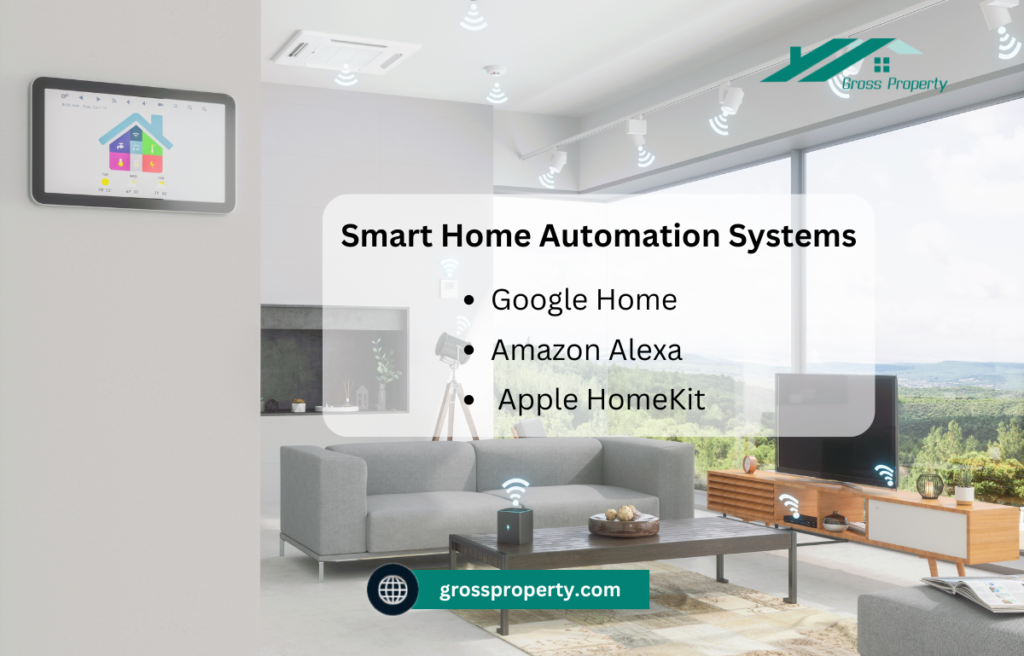Smart home technology is transforming the way we live by integrating advanced systems and devices into our homes that automate everyday tasks and enhance convenience. From controlling your home’s lighting with a smartphone app to managing energy use through smart thermostats, these technologies bring a new level of efficiency and security to modern households. With the growing demand for home automation, the adoption of smart home technology is no longer a futuristic concept but a reality that millions of homeowners are embracing.
The benefits of smart home devices go beyond convenience—they also help save energy, improve home security, and increase the overall value of a property. In this guide, we will explore the key aspects of smart home technology, how it works, and the many ways it is shaping the future of home living.
What Is Smart Home Technology, and How Does It Work?
Smart home technology refers to a network of devices, appliances, and systems that can be controlled remotely via the internet. These devices communicate with each other through various protocols, such as Wi-Fi, Bluetooth, or Zigbee, enabling homeowners to automate and manage tasks like lighting, temperature control, and security. The foundation of smart home technology lies in home automation, which allows devices to function based on preset schedules or triggers, often set through a smartphone app or voice command using systems like Amazon Alexa or Google Home.
The core concept behind smart home technology is connectivity. Devices are interconnected, enabling centralized control and seamless communication across systems. For instance, a smart thermostat can adjust the temperature based on occupancy detected by smart sensors, while a smart security camera can send real-time alerts if it detects unusual activity. As more devices become integrated into homes, the potential for creating fully automated environments grows, allowing for greater convenience, security, and efficiency.
What Are the Most Popular Smart Home Automation Systems?
In the rapidly growing world of smart home technology, several home automation systems stand out for their versatility, ease of use, and integration capabilities. Amazon Alexa is one of the most widely used systems, allowing users to control a variety of smart home devices through voice commands. Alexa integrates with a range of products, including smart lights, thermostats, security cameras, and appliances, making it a popular choice for creating a connected home environment.
Another leading system is Google Home, which provides similar functionality to Alexa but integrates seamlessly with Google’s suite of services, such as Google Assistant and Google Nest products. Google Home excels in voice control and compatibility with a broad range of devices, making it an excellent option for Android users or those already embedded in the Google ecosystem.
Apple HomeKit is another top contender in smart home automation. Known for its strong focus on privacy and security, HomeKit allows Apple users to control smart home devices via the Home app or Siri. HomeKit integrates well with other Apple products, providing a smooth and secure experience for users who prefer the Apple ecosystem. Each of these platforms offers robust features and easy-to-use interfaces, making them some of the most popular choices for homeowners looking to automate their homes.

What Role Does Voice Control Play in Smart Home Automation?
Voice control plays a crucial role in enhancing the functionality and ease of use in smart home automation. Through systems like Amazon Alexa, Google Assistant, and Apple Siri, homeowners can control various smart home devices using simple voice commands. Whether it’s adjusting the thermostat, turning off the lights, locking doors, or playing music, voice control allows users to manage their homes hands-free, offering a seamless and intuitive user experience. This feature is particularly useful for individuals with limited mobility or those who simply prefer the convenience of not having to use a phone or remote to control devices.
Moreover, voice control serves as a central hub for home automation, integrating with a wide range of smart devices such as lights, thermostats, security systems, and appliances. By linking multiple devices to a voice assistant, homeowners can activate customized “scenes” or routines, such as turning off all lights and setting the alarm with a single voice command before bed. This level of integration not only saves time but also enhances the overall smart home experience by simplifying the control of multiple devices.
As voice recognition technology continues to improve, smart home automation is expected to become even more intuitive. Enhanced accuracy in voice commands, along with natural language processing advancements, will make interactions with smart devices more fluid and responsive, further solidifying voice control’s role as a key component in smart homes.
What Are the Benefits of Smart Home Technology for Homeowners?
For homeowners, the adoption of smart home technology offers a multitude of benefits. One of the most notable advantages is convenience. Smart devices like automated lighting systems, smart thermostats, and voice-controlled assistants simplify daily tasks, allowing users to control multiple functions from a single device or app. Whether adjusting the lights, locking doors, or setting the perfect temperature, homeowners can manage their homes effortlessly, often without being physically present.
Another significant benefit is enhanced security. Smart home systems can include smart locks, cameras, and motion sensors that allow homeowners to monitor their property remotely. Many of these devices provide real-time alerts and even allow users to speak with visitors through their smartphones. This level of control offers peace of mind, particularly when traveling or away from home.
Finally, smart home technology contributes to increased property value. Homes equipped with smart systems tend to attract tech-savvy buyers, offering a modern and connected living experience. These features can make a property more appealing in competitive markets and often justify higher listing prices, as smart home integration is seen as a value-added feature.
How Do Smart Home Devices Improve Energy Efficiency?
One of the most impactful benefits of smart home technology is its ability to improve energy efficiency, helping homeowners reduce their carbon footprint while lowering utility costs. Smart thermostats like Nest or Ecobee are prime examples of energy-saving devices. These thermostats learn user preferences and automatically adjust the temperature based on occupancy, weather patterns, and daily schedules, ensuring that energy isn’t wasted when the home is unoccupied.
Similarly, smart lighting systems can further enhance energy efficiency. These systems use motion sensors and timers to turn off lights when they are not in use, reducing electricity consumption. Many systems allow for dimming, which conserves energy while still providing adequate lighting.
In addition to thermostats and lighting, smart appliances such as dishwashers, washing machines, and refrigerators are designed to use less water and electricity. By monitoring energy usage and adjusting settings based on real-time data, smart devices can help homeowners save significantly on energy bills, making their homes both cost-effective and eco-friendly.
How Do Smart Thermostats Save Money on Energy Bills?
Smart thermostats are one of the most effective smart home devices for saving money on energy bills. By using advanced sensors and algorithms, these thermostats automatically adjust heating and cooling based on real-time conditions and occupancy patterns. For example, systems like Nest and Ecobee can learn the homeowner’s daily routine, reducing energy usage when no one is home and ensuring the house is comfortable when occupants return. This intelligent scheduling minimizes unnecessary heating or cooling, leading to significant energy savings.
Additionally, many smart thermostats provide detailed energy reports, allowing homeowners to monitor their energy consumption and identify areas for further efficiency improvements. Some models even offer suggestions for optimizing energy use, such as adjusting the temperature by a few degrees or scheduling system maintenance. Over time, these adjustments can lead to substantial reductions in energy bills.
Smart thermostats also integrate with other smart home systems, allowing for greater control and automation. For instance, they can sync with smart window blinds to optimize sunlight and heat management, or connect to voice-controlled systems for quick adjustments. These features make smart thermostats a critical component in creating an energy-efficient home while delivering both comfort and cost savings.
How Can Smart Lighting Systems Enhance Home Convenience?
Smart lighting systems have become one of the most popular components of smart home technology due to their ability to significantly enhance home convenience. These systems allow homeowners to control their lights through mobile apps, voice commands, or even motion sensors. For example, a smart lighting system can be programmed to turn on or off based on occupancy, eliminating the need for manual switches. This level of automation not only makes daily tasks more convenient but also ensures that lights are never left on unnecessarily, saving energy.
Another way smart lighting enhances convenience is through customizable settings. Homeowners can adjust the brightness and color of lights to suit different moods or activities. For instance, dimming the lights during movie time or creating a specific lighting scene for reading is as simple as tapping a button on a smartphone app. Integration with voice-controlled systems like Amazon Alexa or Google Assistant further adds to the convenience by allowing hands-free control.
Smart lighting systems can also be set on schedules or triggered by other smart devices. For example, outdoor lights can be programmed to turn on automatically when the home security system detects motion, enhancing both convenience and safety. These features make smart lighting systems a key component in creating a comfortable, efficient, and automated living space.
How Do Smart Appliances Simplify Daily Life for Homeowners?
Smart appliances are transforming daily life by adding convenience, efficiency, and automation to household tasks. One of the primary ways smart appliances simplify life is through remote control and monitoring. Devices such as smart refrigerators, ovens, and washing machines can be controlled via smartphone apps, allowing homeowners to start, stop, or monitor their appliances from anywhere. For instance, a smart oven can preheat before the homeowner arrives home, or a washing machine can send alerts when a cycle is complete, reducing the need to constantly check on tasks.
Additionally, smart appliances offer automation features that enhance energy efficiency and convenience. Smart dishwashers and laundry machines can optimize water and energy use based on the load size, ensuring that no excess resources are wasted. Some appliances, like smart refrigerators, can monitor food expiration dates and suggest recipes based on the ingredients available, streamlining meal planning and reducing food waste. This level of automation helps reduce the mental load of managing household chores and ensures that appliances are functioning efficiently.
By integrating with broader smart home systems, these appliances can also be part of routines or scenes. For example, a “Good Morning” routine could automatically start the coffee machine while adjusting the home’s lighting and temperature, making mornings more efficient and enjoyable for homeowners.
What Are the Best Smart Security Systems for Homes?
In 2024, smart security systems have become an essential component of smart home technology, offering advanced features to safeguard homes. One of the top-rated systems is Ring Alarm Pro, known for its comprehensive suite of security features, including motion detection, doorbell cameras, and real-time alerts. Ring’s system integrates with Alexa, allowing homeowners to monitor their property through voice control and remotely view camera footage from their smartphones.
Another popular option is the Arlo Ultra 2, a wireless camera system offering 4K video resolution, color night vision, and two-way audio. It’s ideal for users who want high-quality video surveillance both indoors and outdoors. Arlo’s system is compatible with Google Assistant, Alexa, and Apple HomeKit, making it versatile for different smart home ecosystems.
For those seeking an all-in-one solution, SimpliSafe provides a robust system that includes motion sensors, entry sensors, and video doorbells. Its standout feature is its ease of installation and use, catering to homeowners who want a DIY option. With professional monitoring available, SimpliSafe offers both convenience and peace of mind for homeowners looking to enhance their home’s security.
How Secure Are Smart Home Devices From Cyber Threats?
While smart home technology offers numerous benefits, security is a major concern for homeowners, especially as more devices become connected to the internet. Cybersecurity vulnerabilities can leave smart home devices, such as security cameras, smart locks, and thermostats, exposed to hackers. One of the most common threats is unauthorized access, where hackers exploit weak passwords or unpatched systems to gain control of devices, potentially compromising privacy and safety.
To mitigate these risks, manufacturers are improving the security features of smart home devices. Many devices now come with end-to-end encryption to protect the data transmitted between devices and cloud servers. Additionally, two-factor authentication (2FA) has become a standard feature for smart home systems, adding an extra layer of security by requiring users to verify their identity with a code sent to their mobile devices.
However, security is not solely dependent on the manufacturers. Homeowners need to take proactive steps, such as regularly updating their device firmware, using strong, unique passwords, and securing their home Wi-Fi networks. While no system is entirely immune to cyber threats, these measures significantly reduce the likelihood of security breaches in smart homes.
How Do Smart Home Hubs Integrate with Multiple Devices?
Smart home hubs play a crucial role in integrating and controlling multiple devices within a smart home ecosystem. Hubs act as the central command, allowing different devices—such as lights, thermostats, and security systems—to communicate and work together seamlessly. Popular hubs like Amazon Echo and Google Nest Hub integrate with a variety of smart home products, offering control through voice commands and mobile apps. These hubs make it easier to automate daily tasks by linking devices from different manufacturers.
Zigbee and Z-Wave are two common protocols used by smart home hubs to connect various devices. These protocols allow for low-energy, wireless communication between devices, ensuring that everything from smart lighting to door locks can function together in harmony. For instance, a smart home hub can be set to lock doors, turn off lights, and adjust the thermostat simultaneously when you leave the house, all triggered by a single command.
By using a hub, homeowners can also create routines or scenes, such as a “Goodnight” routine that dims the lights, lowers the thermostat, and locks the doors with one voice command or tap on a smartphone. The integration capabilities of hubs are continuously expanding, making it easier for homeowners to manage all their devices through one centralized system.
What Is the Future of Smart Home Technology in 2024 and Beyond?
The future of smart home technology in 2024 and beyond promises even greater integration, convenience, and automation, driven by advancements in AI and machine learning. One major trend expected to grow is the further development of AI-powered assistants, making smart homes more proactive. These systems will learn user behaviors and preferences in more depth, automating everything from adjusting lighting based on time of day to pre-setting the home temperature based on weather forecasts. AI will enable homes to anticipate and respond to the needs of their occupants without manual input.
Another key area of growth is interoperability—the seamless communication between different smart home devices, regardless of brand or system. Standards such as Matter, a unified platform developed to ensure compatibility across devices, are expected to become more widespread, reducing the current fragmentation in the market. This will allow homeowners to build smart home systems with devices from various manufacturers without worrying about integration issues.
Additionally, smart homes will become increasingly focused on sustainability. Energy-efficient devices and smarter resource management will be a priority as more homeowners seek ways to reduce their environmental impact. Smart appliances, solar-powered systems, and enhanced home automation will help further reduce energy consumption, making homes more sustainable while keeping costs down.
In 2024 and beyond, smart home technology will continue to evolve, offering homeowners more personalized, responsive, and efficient living environments, cementing its role in modern home life.
What Are the Challenges of Adopting Smart Home Technology?
While smart home technology offers numerous benefits, there are several challenges that homeowners may face when adopting these systems. One of the primary issues is compatibility. With a growing number of devices and platforms available, not all products are compatible with each other. Homeowners may struggle to integrate devices from different manufacturers into one cohesive system, leading to frustration and the need for additional hubs or adapters.
Another challenge is security concerns. As more devices connect to the internet, the risk of cyberattacks increases. Many smart devices lack robust security features, leaving them vulnerable to hacking. Homeowners must take proactive steps, such as using strong passwords, regularly updating firmware, and enabling two-factor authentication, to protect their smart home systems from cyber threats.
Additionally, the cost of adoption can be a barrier for some homeowners. While the long-term benefits of smart home technology, such as energy savings and convenience, are appealing, the initial investment in devices, hubs, and professional installations can be high. This upfront cost can deter some individuals from fully integrating smart home technology into their homes, especially if they are unsure about the return on investment.
How Do Smart Home Technology Impact Property Values?
Smart home technology is becoming increasingly important in real estate, with a notable impact on property values. Homes equipped with smart devices such as smart thermostats, security systems, and smart lighting are seen as more desirable in the market. Buyers are often willing to pay a premium for homes that offer home automation and the conveniences associated with it, such as enhanced security, energy efficiency, and ease of control through mobile devices. This makes smart home technology an appealing investment for homeowners looking to increase their property’s market value.
Furthermore, smart home technologies are becoming a key differentiator in competitive markets. Properties featuring advanced security systems, smart locks, and energy-efficient appliances stand out from traditional homes, attracting tech-savvy buyers who prioritize modern conveniences. In high-demand markets, these features can lead to faster sales and higher asking prices, as buyers view them as valuable, long-term investments.
Real estate agents are also reporting that smart homes often receive more interest during open houses and viewings, as prospective buyers appreciate the ability to integrate smart home hubs with their existing devices. This added interest can lead to quicker sales and improved property value, especially as the adoption of smart home technology continues to rise.
What Is the Environmental Impact of Adopting Smart Home Technology?
The adoption of smart home technology has a significant positive impact on the environment, particularly through energy efficiency and resource conservation. Devices like smart thermostats, smart lighting, and smart appliances are designed to reduce energy consumption by optimizing their operation. For example, a smart thermostat adjusts heating and cooling based on occupancy, ensuring that energy is not wasted when no one is home. Similarly, smart lighting systems can be programmed to turn off automatically when not in use, reducing electricity consumption.
In addition to energy savings, smart appliances like dishwashers and washing machines are equipped with sensors that optimize water usage, using only the necessary amount for each load. This helps reduce water waste, contributing to more sustainable household practices. Over time, the cumulative effect of these energy and water-saving measures leads to lower utility bills and a reduced carbon footprint for homeowners.
Moreover, the growing integration of solar-powered systems and renewable energy solutions with smart home technology is further enhancing its environmental benefits. Homeowners can monitor and manage their energy consumption in real time, adjusting usage based on peak hours and reducing their reliance on non-renewable energy sources. This shift towards smarter, more efficient homes is helping pave the way for a more sustainable future, with long-term benefits for both homeowners and the environment.
Smart home technology is rapidly transforming how we live, offering a blend of convenience, efficiency, and security that simplifies daily life for homeowners. From smart appliances that optimize household chores to smart security systems that enhance safety, these technologies are becoming an integral part of modern homes. Not only do they provide immediate benefits in terms of energy savings and automation, but they also increase property value, making them a sound investment for homeowners and an attractive feature for prospective buyers.
As we look toward the future, the environmental impact of smart home technology continues to be a driving force in its adoption. The ability to conserve energy and resources through automated systems supports both sustainability goals and cost savings for households. With the growing integration of renewable energy solutions and more advanced home automation, smart homes are set to play a significant role in shaping more eco-friendly and efficient living environments.
Moreover, the rise of smart home technology is closely linked with broader real estate tech trends, as homebuyers increasingly expect modern, connected homes. As these trends evolve, properties equipped with smart technologies will continue to stand out in competitive markets, offering both functionality and long-term value. Homeowners and investors alike should consider how these innovations are redefining the real estate landscape, making technology an essential component of the future home.











